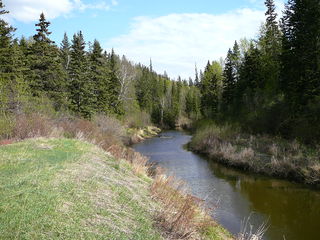Babine River Corridor Provincial Park is a provincial park in British Columbia, Canada, located to the north of Hazelton. The park was established by Order-in-Council in 1999 and is approximately 15,339 hectares in area.
Bulkley Junction Provincial Park is a provincial park in British Columbia, Canada, located on the west side of the Skeena River opposite Hazelton.
Cottonwood River Provincial Park is a provincial park in British Columbia, Canada, located northeast of the confluence of the Fraser and Cottonwood Rivers in that province's North Cariboo region.
Denetiah Provincial Park is a provincial park in British Columbia, Canada. It is part of the larger Muskwa-Kechika Management Area. Established in 1999 and at 90,379 ha. in area, it is located west of the Kechika River between the Turnagain and Frog Rivers. The park includes Denetiah Lake and Dall Lake. Dune Za Keyih Provincial Park and Protected Area is to its east across the Kechika, while the Dall River Old Growth Provincial Park is on its northwest flank. Horneline Creek Provincial Park is 30 km to the north.
Dall River Old Growth Provincial Park is a provincial park in British Columbia, Canada. It is part of the larger Muskwa-Kechika Management Area and is located immediately northwest of Denetiah Provincial Park, northwest of the junction of the Gataga and Kechika Rivers. Established in 1999, the park is 642 ha. in area. The park protects areas of white spruce old growth.
Seeley Lake Provincial Park is a provincial park in British Columbia, Canada, located south of the confluence of the Skeena and Bulkley Rivers at Hazelton, and to the south of that settlement.
Tatlatui Provincial Park is a provincial park in British Columbia, Canada, located at the southern end of the Spatsizi Plateau and around the headwaters of the Firesteel River, part of the Finlay-Peace River basin and therefore in the Arctic drainage. Thutade Lake, at the head of the Firesteel and to the southeast of the park, is considered the ultimate source of the Mackenzie River.
The Stikine Ranges are a group of mountain ranges and mountainous plateaus in northwestern British Columbia, Canada. They are the northernmost subdivision of the Cassiar Mountains and among the least explored and most undeveloped parts of the province.

Whitemud Creek is a tributary of the North Saskatchewan River in central Alberta, Canada.
Chapada is a municipality in the state of Rio Grande do Sul, Brazil.

The Kitlope River is a river in the Kitimat Ranges in the North Coast of British Columbia, Canada, flowing north into the head of the Gardner Canal to the south of the smelter town of Kitimat. It is named for the Gitlope group of Haisla, now part of the Haisla Nation government and community at Kitamaat Village near Kitimat. The name is a Tsimshian language reference to the people, who call themselves Henaksiala, and means "people of the rocks" or "people of the opening in the mountains". The Haisla language name for the river is Xesduwaxwsdu.
Kitlope 16, properly the Kitlope Indian Reserve No. 16, is an Indian Reserve on the North Coast of British Columbia, to the south of Kitimat, British Columbia and at the mouth of the Kitlope River, which flows north into the head of the Gardner Canal to the south of that town. It is the home reserve of the Henaksiala or Kitlope or Gitlope group of the Haisla, who are now part of the Haisla Nation government and settled with the Haisla at Kitamaat Village, the reserve community near Kitimat.
The Tenaiko Range is a small subrange of the Kitimat Ranges in British Columbia, Canada. It is surrounded by the Gamsby River and Tenaiko Creek. It reaches a height of 1,042 meters above sea level.
The Whitesail Range is a subrange of the Tahtsa Ranges, located north of Whitesail River in northern British Columbia, Canada.
Monte Lake is a small lake in southern British Columbia, Canada roughly between Kamloops and Vernon. The lake is adjacent to British Columbia Highway 97 in the valley connecting Falkland to the South Thompson Country at Monte Creek where that highway merges with the Trans-Canada Highway to Kamloops. The community of Monte Lake is at its north end, while along its eastern shore is the eight hectare Monte Lake Provincial Park.
The Tezwa River is a river in the Kitimat Ranges of the Coast Mountains in British Columbia, Canada. It is part of the Kitlope River drainage, feeding that river via the head of Kitlope Lake.
Cornice Peak, 2093 m, is a mountain in the Kitimat Ranges of the Coast Mountains in British Columbia, Canada. It is located on the west side of the Kimsquit River just northwest of the head of Dean Channel. The Kapella River, a tributary of the Kitlope, rises on the west side of Cornice Peak.
The Tsaytis River is a river in the Kitimat Ranges of British Columbia, Canada, flowing southwest from its sources in those mountains into the North Coast of that province at the head of the Gardner Canal, adjacent to the mouth of the Kitlope River.

The Gamsby River is a river in the Kitimat Ranges of the North Coast region of British Columbia, Canada. It flows southwest to meet the Kitlope River, of which it is a tributary.
On 26 June 1990, the Provisional IRA detonated a bomb at the Carlton Club, a club in London popular among MPs and supporters of the ruling Conservative Party. The bombing injured 20 people, one of whom, Lord Kaberry of Adel, died a year later. The ground collapsed to the basement and windows were shattered. The blast was felt up to half a mile away.






